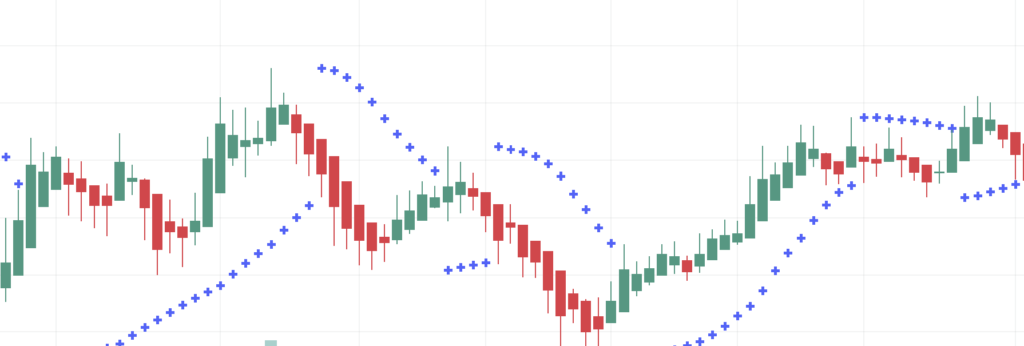The Parabolic SAR indicator helps the trader determine the direction in which the security is moving, and helps determine possible reversals in the trend. It usually is shown with circles or stars, below the price in an uptrend, and above the price in a downtrend.

The Parabolic SAR, developed by J. Welles Wilder Jr., stands for Parabolic “stop and reverse” because of its ability to identify potential reversals in price movement. This indicator is a popular choice for those who partake in scalping.
Strategies
There are many strategies a trader may incorporate into their Parabolic SAR trading, some of which may involve mixing it with other indicators and chart patterns.
Regular Strategy
The general use of the Parabolic SAR is to identify the position of the indicator relative to the price, and to watch for any jumps in position of the indicator.
When the indicator is below the price, the security is said to be in an uptrend. When the indicator is above the price, the security is said to be in a downtrend.
Using the position of the indicator can help traders by increasing their confidence in their position, or potential position. It can act as confirmation for the trader if he/she expects the trend to continue in that direction.
Another part of the strategy is the changing of the indicator’s position from above to below and below to above the price. When the indicator moves from below to above, it may indicate a bearish signal in price, and when the indicator moves from above to below the price, it may indicate a bullish signal.
Traders may use this as an indication to enter a trade, or use it as additional confirmation to a trade which is generally seen as more wise than just using the indicator solely to make a decision on a security.
Breakout Strategy
By using the flipping nature of the indicator, a trader can attempt to predict and trade breakouts. It is one of the simplest strategies, yet it is effective if performed properly and if the chart responds properly.
For this breakout strategy, some traders wait for a pullback. Then, on the flipping of the indicator, the trader may enter the trade. The flipping of the indicator would be a confirmation signal. Let’s look at an example here:

In this chart, we see that the price broke out past a line of resistance. Then, it pulled back, which is very common on breakouts. (Learn more about breakouts here).
On the pullback, the Parabolic SAR indicator flipped to above the price, signaling a downtrend. A trader may wait for the indicator to flip back to below the price after a pullback, and use this as a trading opportunity.
The Double Parabolic SAR Strategy
This strategy, instead of it using two Parabolic SAR indicators, actually uses two different time frames to find trading opportunities.
It requires a longer-term time frame, and a shorter-term time frame. The specific time frames do not matter, as long as one is longer than the other.
The strategy requires the trader to identify the trend based on the position of the Parabolic SAR. This is done on the longer-term time frame.
So, if the Parabolic SAR is generally below price on the longer-term time frame, then the overall trend is usually said to be an uptrend.
On the shorter-term time frame, trades would only be made, based on the indicator, in the direction of the trend identified in the longer-term time frame.
So, if a trader identified an uptrend in the longer-term time frame, then the trader would make trades in the shorter-term time frame that were in the direction of the uptrend.
Risks
As with any indicator, there are risks to using the Parabolic SAR, as there are risks to trading.
The Parabolic SAR generally performs well in a trending market, but can lead to many false signals during a choppy or sideways market. If the trader does choose to trade in the sideways market, he/she should wait for confirmation on a trade.
Overall, this is a great indicator to know but not without other knowledge of the stock market and an understanding that there is always risk.
